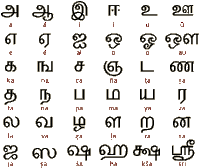 by Sebastian Rasalingam
by Sebastian Rasalingam
There has been a number of articles recently, e.g, Groundviews (Feb.22, 2008) on "Ethnos or Demos?- questioning Tamil nationalism, and various responses to it. Other news media have published other articles, e.g., that of Mr. Rohana Wasala (The Island, 18-March-2008), as well the comments made by the Island columnist Shanee, mainly touching on the Estate Indian citizenship act and its relatiuon to the Tamil question. Some clarity can be achieved if the historical settings to these issues were revisited.
A distorted picture of the Indian citizenship act (1948 and 1949) was launched by S. J. V. Chelvanayakam and others partly as a means of attacking G. G. Ponnambalam, who at that time held the leading position in Tamil politics. At the end of the Soulbury commission's sittings, a sense of healing between the communities took place, largely because Senanayake had imposed a dignified silence, instead of a heated exchange between communities in front of the Soulobury commission. It was at this point that G. G. Ponnambalam, Arunachalam Mahadeva, Natesan and others called for "responsible cooperation" with the Sinhalese leaders and supported the new Senanayake government.
Chelvanayakam and others proposed the two-nation concept (instead of the failed fifty-fifty approach). One aspect of this proposal was to regard the Sinhalese as invaders of the Tamil homeland which had already begun to be defined, for example, with the formation of a society calling itself the "All_Ceylon Aboriginal Inhabitants of Jaffna", coming into being in May 1940 (Hindu Organ, May 13, 1940). The Ilankai Thamil Arasu Katchchi (ITAK) hoped to use the example from India, where the mass Satyagrahas finally drove out the British, as the weapon to unleash against the Sinhalese. This policy required a deliberate attempt to discredit the Seananayakas and others who stood for the "one-nation of Ceylonese" concept. Collaborators with the Sinhalese automatically became traitors or " thurogis". Thus it was how G. G. Ponnambalam was declared a traitor by the ITAK. With this turn of events, the ITAK was not a pan-Ceylonese party even for appearance's sake. Its task was to destroy any bridges which existed between the two communities, and insist that the Tamils, with their grander history and destiny, are utterly different from the Sinhalese, and should seek its own "Arasu".
In 1952 the language issue had not come to the front stage. Senanayake had indicated his support for parity of administrative usage for the two languages, but clearly did not wish to make this into a public issue. The burning battle that took place between the ITAK and the Tamil Congress (TC) in 1952 was over the Indian citizenship act. Ponnambalam and Natesan of the TC were contested by Chelvanayakam and Naganathan, and it was during this election that the highly distorted picture of the Indian citizenship act was presented to the Tamils of Jaffna. The ITAK as well as the Marxist leaders in the South went around building a picture of Senanayake as a sinhala racist who has rendered a million Tamils "stateless". Senanayake's citizenship act, drawn up with the help of leading Tamils (like Vaithiyalingam), and most probably with the advice of Senanayake's principal constitutional Guru, Ivor Jennings, was actually an unusually liberal document, when viewed against the practices that existed at that time in other parts of the world. The Canadian "Indian" citizenship act, applied in 1952 to (native) Canadian Indians, required that an Indian be judged "civilized" by a white government official before he could enjoy the rights of schooling, health care and other basic amenities. Or else he had to remain shut out from the external world in "Indian Reserves". Senanayake's citizenship act required seven years of residence in Ceylon as a condition for citizenship. Compare this with the Hispanic workers in America today. The Hispanics were the original inhabitants of California, New Mexico and Southern Texas. But Spanish is not a recognized official language, and California does not attempt to reserve its borders to Hispanics as their homeland. The millions of Hispanic workers are so essential to the US economy that it would collapse if they were to go on a mass work-stoppage. And yet, a Hispanic worker cannot even get a "green card" without jumping through many hoops.
The ITAK had to build up a repertoire of original sins committed by the "Sinhalese invaders of the Tamil home lands", if its political program of driving a wedge between the two communities were to succeed. Note that this is already in the period PRIOR to the arrival of "Sinhala Only". I list the following which have become "accepted beliefs", mainly among the Colombo Tamil intellectuals of the younger generation (i.e., those who grew up after the World War II).
The litany of sins began with the famous claim of "deception" of Ponnambalam Arunachalam (AP), by the Sinhalese leaders, in the early 1920s, in regard to the "Colombo seat". At that time, all politicians, be they Sinhala or Tamil, were beholden to the Governor for their political positions. If the Governor had given even the slightest indication that he wanted AP appointed to the Colombo seat, the Sinhala leaders would have rushed to execute the Governor's wish. AP himself realized that the Governor needs to be wooed, and that is why he invited the Governor to Jaffna, received him lavishly and presented a secret proposal asking that he be appointed. Unfortunately for AP, the Lake House press managed get a copy and to splash the "secret memorandum", ensuring that the Governor turned against a highly embarrassed AP. Not surprisingly, it heralded the end of AP's political career. AP claimed that two Sinhalese leaders who had promised to support him had deceived him, and left politics claiming to be "disgusted with such "deception". And yet, this incident which reflect the vanity and political incompetence of Arunachalam Ponnamblam has become the primodial "origin sin" cited by Tamil Nationalism.
The next weapon of assault used by the ITAK was simply taken from G. G. Ponnambalam's list of grievances that had been presented to Soulbury, viz., the discriminatory Sinhala colonization policy claimed to have been "set in motion" by Senanayake, and his predecessors under the aegis of the the Colonial Government. It is unfortunate that the Tamil nationalist movement continues to make the false claim that the 1925-1955 period was an example of Sinhalese land grab. Soulbury's report as well as the analyses of most historians reject this claim. The claim forgets that most of the top civil servants who ran the Galoya board were Tamils.
We have already discussed how the Indian citizenship act was a god-send to the ITAK which was trying hard to build a political case for itself. However, the Jaffna electorate and the Tamil intelligencia of the early 1950s did NOT buy Chelvanayakm's platform. The learned judges of the Ceylon supreme court, and the Privy council in London, both rejected a case filed against the Citizenship Act by the ITAK, and judged that no discrimination had occurred either before, or after the act. The strident cry that Senanayake was a Sinhala racist cut no ice at that time. Every one knew that in March 1939 it was Senanayake who moved to exclude the Sinhala Communalist extremists from the Ceylon National Congress. Senanayake and Francis de Soyza held that "the first plank must be nationalism against communalism. Ceylon for the Sinhalese is as a good slogan which will go down with the Sinhalese villager. There are those who say they are prepared to die for the Sinhalese. The sooner they die, the better it will be for the Sinhalese " (Hindu Organ, March 6, 1939). It should be remembered that these were strong words in 1939, although they may sound tame in today's context of the politics of Terror and Suicide.
Another weapon of assault is the so called "Mahavamsa mind set". This was brought to the political front, at least as far as the Tamil public is concerned, by G. G. Ponnambalam. This rapidly raised his stand among Jaffna nationalists, but also invigorated SWRD's counter campaigns of racial rivalry. The Mahavamsa had indeed been used by Anagarika Dharmapala (a sinhala Buddhist version of Navalar), mainly against Christian evangelism, but no one used it as well as GGP in rousing up the public, and calling for a "Dravidian" pride. The "Dravidian" concept soon gave way to pure Tamil nationalism. The latter has led to suicide cadre and political assisinations. Thankfully, the "Mahavamsa mindset" has only launched a set of political monks who may prove be the best argument against that mindset!
The ITAK came to the political fore-front only after the UNP, with Kotalawala at the helm, totally bungled the language issue. S.W.R.D. Bandaranaike (SWRD) swept the polls with his unmistakable jingoist cries. The ITAK could now add a genuine grievance to its litany of anger against the Sinhalese. This gave the ITAK an emotional basis for its "satyagraha" campaigns, within the concept that the Sinhalese are invaders of the Tamil homeland. This was, I believe, a grave error. Unlike the period 1925-1955, we now entered an era where the Sinhala leadership had NOT earned the trust of the minorities. Unlike Senanayake and others who had the disciplinarian mentality of estate superintendents, Bandaranaike and the Marxists believed in spontaneous uprisings of the masses where "normal justice" was replaced by some romantic, wild form of "justice". The tamils would get "punished" for their "rapacious claims" by the ofrces of natural justice. Is that why SWRD did not enforce law and order when the riots irrupted in 1957? The Indian model of "satyagraha" against the invader worked because the party carrying out the Satyagraha was a vast majority (of Indians) against the British Colonial administration. The ITAK program merely exacerbated the already inflamed political situation, with the certain guarantee that Tamils will suffer violence in the hands of racial mobs as well as the state. The actions of Tamils led by the ITAK were no different from a small Tibetan minority trying to contest the Chinese state. Worst of all, the arrogant Queen's counsels who led the ITAK were fool enough to believe that a Nationalist Sinhala government would simply hand over a coastline starting from Puttalam and going around the perimeter along the eastern coast upto Pottuvil, simply because they launched a program of civil disobedience! Their political blindness was caused by their nationalism which was as chauvinist as that of the Sinhalese extremists.
The ITAK activities further polarized the two ethnic groups and brought us to the horror that we have today. As feelings hardened, earlier nationalists were labeled "thurogi" and bumped off. A large body of post-war Tamil intelligentsia completely believe the distorted litany of grievances popularized so ably by Chevanaakam, A. J. Wilson and others. So I am not surprised by the contents of Shanee's column in The Island. We had a small window of opportunity to grab the reality that the Tamils and the Sinhalese are nearly identical people in language, culture and religion. But we failed. Of course, the Colombo Tamil leadership was predominantly Christian and unaware of Tamil culture, except that the caste system endorsed their pre-eminence. It is interesting to note that the Batticaloa Tamil leadership had actually, even in the 1930s and 40s, followed a path very different to that indicated by the Colombo Tamils. Mr. E. R. Tambimuttu, coming from Batticaloa was the only Tamil to support the Donoughmore constitution and universal franchise. He opposed Ponnambalam's 50-50 proposals and also objected to Ponnambalam's attempts to speak on behalf of the Muslims (Hansard 1939, Column 1705). The modern dissociation of the politics of the Eastern province from that of the North, under Karuna and Pilliyan goes back to perhaps 1910.
The main grievance of the Tamils (and indeed, certain sections of the Sinhalese), at least as I see it today, is that they cannot be sure of their personal safety under a sinhala administration. This problem requires stringent enforcement and respect of the law, and creating conditions of trust between the various ethnic groups of the nation. The bridge building must come by noting the similarities and commonalities of all the citizens of the country. These constitute the core needs of employment, health, education and security. The two major ethnic groups are so close linguistically, culturally, and by consanguinity that what we have in Sri Lanka is nothing but a fratricidal battle.
We have to stop the round of accusations and counter-accusations, about AP's deception, Senanayake's citizenship act, Mahavamsa mind set, etc, etc., and find what we can do together. Black July should not be a day to beat up a lather of frenzy against the Sinhalese. It should be the day when we re-collect that Tamils killed Duraiappah and many other worthy leaders. Every Jaffna Tamil, when he makes it good, migrates to Colombo, and form thence even to foreign lands. Tamils have excelled in commerce, banking, the professions, worked and lived everywhere in the Island with all ethnic communities. This will happen again, when a new set of Tamil leaders and intellectuals, possibly coming from the Estate Sector, NOT wedded to the myths and litany of grievances of the Colombo clan, ecomes up from the ashes of today.
Saturday, March 22, 2008
Regarding some basic beliefs of Tamil Nationalism which have misled the Tamils
Posted by media at 12:52 AM 2 comments
Friday, March 21, 2008
False propaganda regarding re-deployment of Special Task Force from the Eastern Province
The Government rejects the reports in the printed and electronic media referring to the 'total' re- deployment of the Special Task Force(STF) today (21) from the Eastern province as being totally incorrect. Re- deployment of Forces on considerations of Troop levels, requirements, exigencies of the service and ground realities are considered routine for the Police and such matters should not be reported by the media in a manner at this critical juncture and time which could be an advantage to the enemy .
Meanwhile, some media reports of 21st March indicate that the re- deployment of the STF has been made at the instigation of the TMVP in the Batticaloa District . The Government reiterates that the STF was re - deployed to strengthen the TMVP which predominates the Batticalao District and as the Government rejects such media report as a total fabrication and distortion of facts.
Ground realities with reference the strengths available and required in relation to the task of providing the security expected and other matters are some considerations that have resulted in the re-deployment of the STF. The Government whilst reminding that the entire STF has not been re- deployed , calls on the media to correct the false interpretations in the printed and electronic media of today (21).
Posted by media at 9:58 PM 0 comments
Maruti most preferred imported car in Lanka
New Delhi (PTI): Country's largest car maker Maruti Suzuki India has emerged as the most preferred 'imported car manufacturer' in neighbouring Sri Lanka.
The company said that according to recent import statistics released by the Sri Lankan government, it has been declared the most preferred "imported car manufacturer".
This is the fifth year in succession that MSI has bagged the position, it said in a statement.
The company has so far exported over 3,600 units to Sri Lanka, it added. Cumulatively, Maruti has exported over 26,000 units since it started operations in Sri Lanka in 1989-90 with a first batch of 10 vehicles.
The car maker's most popular model Maruti-800 alone accounts for over 16,000 units in Sri Lanka, besides Alto and Swift being the other popular models. It exports all the models to Sri Lanka, but SX4.
According to the import study by the Sri Lankan government, MSI said there had been a shift in consumer's choice from second-hand imported vehicles to new cars.
Sale of new car in the island nation spurred after its government incentivised new vehicle purchases over used or refurbished, which a senior Maruti official termed as "a positive development".
Posted by media at 9:57 PM 0 comments
Sri Lanka says 22 rebels killed in fresh fighting
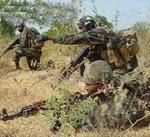 COLOMBO (AFP) - Fighting between government troops and Tamil Tigers across Sri Lanka's war-ravaged northern districts claimed at least 22 rebel lives, the defence ministry said Thursday.
COLOMBO (AFP) - Fighting between government troops and Tamil Tigers across Sri Lanka's war-ravaged northern districts claimed at least 22 rebel lives, the defence ministry said Thursday.
Security forces killed the rebels during artillery duels in Jaffna, Weli Oya, Mannar and Vavuniya on Wednesday, the ministry said, adding that two soldiers were wounded.
The government's casualty claims could not be verified and there was no immediate comment from the Liberation Tigers of Tamil Eelam (LTTE), who control a swathe of territory in the island's north.
The government claims it has killed 2,212 rebels since January against the loss of 130 of it own troops.
Both sides are known to offer wildly fluctuating claims that cannot be independently verified as the government prevents reporters and rights groups from visiting frontline areas.
Tens of thousands have died since the LTTE launched a separatist campaign in 1972 to carve out an independent homeland for minority Tamils in the island's north and east.
Posted by media at 12:12 AM 0 comments
Sri Lanka criticised over TV boss
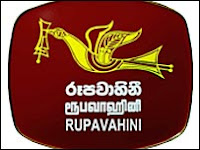 Media rights activists in Sri Lanka have criticised the appointment of a retired army officer to a senior post in the state-run television station.
Media rights activists in Sri Lanka have criticised the appointment of a retired army officer to a senior post in the state-run television station.
Former army major general Sunil Silva has been made deputy director general of Rupavahini, the most widely watched TV station in the country.
The Free Media Movement said the move would give the government more control over the station during a crisis.
The government rejected the charge, saying it would strengthen the station.
The move comes days after employees of the station protested over a series of assaults on five of their colleagues.
Sunanda Deshapriya of The Free Media Movement told the BBC that Maj Gen Silva's appointment was "part of the general militarisation of the country".
"This is unprecedented," he said. "No retired military person has been appointed for the top post in the last 20 years."
Sri Lankan Media Minister Anurapriyadarshana Yapa dismissed the criticism as "propaganda".
He said Mr Silva "has not been given any mandate to run the station".
"He has been appointed only to help the administration."
BBC
Posted by media at 12:09 AM 0 comments
Thursday, March 20, 2008
Bail granted to man charged in B.C. for allegedly raising funds for terrorists
The Toronto-area man who is the first person in Canada to be charged with helping finance terrorists was granted bail in a British Columbia court Tuesday. Prapaharan Thambithurai, 45, was released on $25,000 bail. After leaving Vancouver Provincial Court, he was picked up by his wife, who was driving a black Cadillac Escalade.
Prapaharan Thambithurai, 45, was released on $25,000 bail. After leaving Vancouver Provincial Court, he was picked up by his wife, who was driving a black Cadillac Escalade.
Thambithurai is accused of asking people in Metro Vancouver for donations to the Tamil Tigers, a group seeking an independent homeland in Sri Lanka.
Formally known as the Liberation Tigers of Tamil Elam, the Tigers were declared a terrorist group by the Canadian government two years ago, which makes it illegal to raise money for them.
The RCMP's Integrated National Security Enforcement Team arrested Thambithurai in New Westminster last Friday.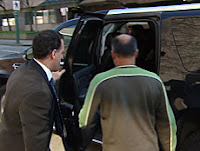 It is alleged that Thambithurai committed an offence under Section 83.03(b) of the Criminal Code of Canada, the section that makes it an offence to provide, or make available property or services for terrorist purposes.
It is alleged that Thambithurai committed an offence under Section 83.03(b) of the Criminal Code of Canada, the section that makes it an offence to provide, or make available property or services for terrorist purposes.
Michel Juneau-Katsuya, a former agent for the Canadian Security Intelligence Service (CSIS) who is now a security consultant with Ottawa-based Northgate Group, said before the group was outlawed, it managed to raise an average of $10 million from Canada's relatively small Tamil community.
Juneau-Katsuya said the group did it by terrorizing members of the Tamil community by threatening repercussions for family back in Sri Lanka if money wasn't given.
Thambithurai spoke briefly to reporters outside the court before getting into the waiting Cadillac.
When asked whether he thought he had done anything wrong, he replied with a terse "No."
CBC
Posted by media at 12:37 AM 0 comments
Sri Lankan Airlines chases Indians
 Sri Lankan Airlines, already the biggest foreign carrier to India with over 100 flights a week, says it is intensifying efforts to attract Indians to fly its network and bring them to its hub in Colombo.
Sri Lankan Airlines, already the biggest foreign carrier to India with over 100 flights a week, says it is intensifying efforts to attract Indians to fly its network and bring them to its hub in Colombo.
More than 100,000 Indians visited Sri Lanka in 2007, with authorities expecting volume to double in the next two years.
In February the airline had offered discounted fares for Indian travellers below the age 27 provided they stayed in the island for three days.
"India is the largest country of origin of tourists to Sri Lanka, having replaced our earlier traditional markets in Europe every year since 2005," Senaka Fernando, regional manager for India and Maldives said in a statement.
The airline says flight time to Sri Lanka is less than an hour from six out of 11 Indian destinations it flies to.
It carries North Indian, South Indian and vegetarian dishes and the latest Hindi and Tamil films on its entertainment system.
Courtesy: LBO
Posted by media at 12:26 AM 0 comments
Wednesday, March 19, 2008
Arthur C. Clarke passes away at age 90 in Sri Lanka
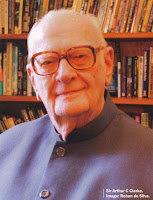 COLOMBO, Sri Lanka - Arthur C. Clarke, a visionary science fiction writer who co-wrote "2001: A Space Odyssey" and won worldwide acclaim with more than 100 books on space, science and the future, died Wednesday, an aide said. He was 90.
COLOMBO, Sri Lanka - Arthur C. Clarke, a visionary science fiction writer who co-wrote "2001: A Space Odyssey" and won worldwide acclaim with more than 100 books on space, science and the future, died Wednesday, an aide said. He was 90.
Clarke, who had battled debilitating post-polio syndrome since the 1960s, died at 1:30 a.m. in his adopted home of Sri Lanka after suffering breathing problems, aide Rohan De Silva said.
Co-author with Stanley Kubrick of Kubrick's film "2001: A Space Odyssey," Clarke was regarded as far more than a science fiction writer.
He was credited with the concept of communications satellites in 1945, decades before they became a reality. Geosynchronous orbits, which keep satellites in a fixed position relative to the ground, are called Clarke orbits.
He joined American broadcaster Walter Cronkite as commentator on the U.S. Apollo moonshots in the late 1960s.
Clarke's non-fiction volumes on space travel and his explorations of the Great Barrier Reef and Indian Ocean earned him respect in the world of science, and in 1976 he became an honorary fellow of the American Institute of Aeronautics and Astronautics.
But it was his writing that shot him to his greatest fame and that gave him the greatest fulfillment.
"Sometimes I am asked how I would like to be remembered," Clarke said recently. "I have had a diverse career as a writer, underwater explorer and space promoter. Of all these I would like to be remembered as a writer."
From 1950, he began a prolific output of both fiction and non-fiction, sometimes publishing three books in a year. He published his best-selling "3001: The Final Odyssey" when he was 79.
Some of his best-known books are "Childhood's End," 1953; "The City and The Stars," 1956, "The Nine Billion Names of God," 1967; "Rendezvous with Rama," 1973; "Imperial Earth," 1975; and "The Songs of Distant Earth," 1986.
When Clarke and Kubrick got together to develop a movie about space, they used as basic ideas several of Clarke's shorter pieces, including "The Sentinel," written in 1948, and "Encounter in the Dawn." As work progressed on the screenplay, Clarke also wrote a novel of the story. He followed it up with "2010," "2061," and "3001: The Final Odyssey."
In 1989, two decades after the Apollo 11 moon landings, Clarke wrote: "2001 was written in an age which now lies beyond one of the great divides in human history; we are sundered from it forever by the moment when Neil Armstrong and Buzz Aldrin stepped out on to the Sea of Tranquility. Now history and fiction have become inexorably intertwined."
Clarke won the Nebula Award of the Science Fiction Writers of America in 1972, 1974 and 1979; the Hugo Award of the World Science Fiction Convention in 1974 and 1980, and in 1986 became Grand Master of the Science Fiction Writers of America. He was awarded the CBE in 1989. Born in Minehead, western England, on Dec. 16, 1917, the son of a farmer, Arthur Charles Clark became addicted to science fiction after buying his first copies of the pulp magazine "Amazing Stories" at Woolworth's. He read English writers H.G. Wells and Olaf Stapledon and began writing for his school magazine in his teens.
Born in Minehead, western England, on Dec. 16, 1917, the son of a farmer, Arthur Charles Clark became addicted to science fiction after buying his first copies of the pulp magazine "Amazing Stories" at Woolworth's. He read English writers H.G. Wells and Olaf Stapledon and began writing for his school magazine in his teens.
Clarke went to work as a clerk in Her Majesty's Exchequer and Audit Department in London, where he joined the British Interplanetary Society and wrote his first short stories and scientific articles on space travel.
It was not until after the World War II that Clarke received a bachelor of science degree in physics and mathematics from King's College in London.
In the wartime Royal Air Force, he was put in charge of a new radar blind-landing system.
But it was an RAF memo he wrote in 1945 about the future of communications that led him to fame. It was about the possibility of using satellites to revolutionize communications — an idea whose time had decidedly not come.
Clarke later sent it to a publication called Wireless World, which almost rejected it as too far-fetched.
Clarke married in 1953, and was divorced in 1964. He had no children.
He moved to the Indian Ocean island of Sri Lanka in 1956 after embarking on a study of the Great Barrier Reef.
Clarke, who had battled debilitating post-polio syndrome since the 1960s and sometimes used a wheelchair, discovered that scuba-diving approximated the feeling of weightlessness that astronauts experience in space. He remained a diving enthusiast, running his own scuba venture into old age.
"I'm perfectly operational underwater," he once said.
Clarke was linked by his computer with friends and fans around the world, spending each morning answering e-mails and browsing the Internet.
At a 90th birthday party thrown for Clarke in December, the author said he had three wishes: for Sri Lanka's raging civil war to end, for the world to embrace cleaner sources of energy and for evidence of extraterrestrial beings to be discovered.
In an interview with The Associated Press, Clarke once said he did not regret having never followed his novels into space, adding that he had arranged to have DNA from strands of his hair sent into orbit.
"One day, some super civilization may encounter this relic from the vanished species and I may exist in another time," he said. "Move over, Stephen King."
Associated Press
Posted by media at 6:03 AM 1 comments
Tuesday, March 18, 2008
Canadian raised funds for Tamil Tigers, RCMP alleges
The RCMP says an Ontario man who was scheduled to appear in a Vancouver courtroom this morning to face Canada's first terrorism financing charge was collecting money for Sri Lanka's Tamil Tigers.
Prapaharan Thambithurai is accused of collecting money from ethnic Tamils in B.C.'s Lower Mainland that was destined for the Liberation Tigers of Tamil Eelam, or LTTE, a foreign terrorist organization under Canadian law.
A senior B.C. counter-terrorism officer said Mr. Thambithurai, aka "Prapa," was soliciting donations for the World Tamil Movement (WTM), which police say is the leading Tamil Tigers front organization in Canada.
"There's no doubt he was collecting funds for the WTM, ultimately with the linkage to the LTTE," said Superintendent Lloyd Plante, head of B.C.'s counter-terrorism squad, the Integrated National Security Enforcement Team.
He called the charge a "first for Canada."
Mr. Thambithurai is a resident of Maple, Ont., north of Toronto. A spokesman for the Canadian Tamil Congress, David Poopalapillai, said he did not know the 45-year-old, whom police said was a Canadian citizen.
"Collecting money for the Tigers is unlawful activity," said Mr. Poopalapillai, who speaks for one of Canada's most prominent Tamil community groups. "The Canadian Tamil Congress, we don't condone any illegal activity."
But many Canadian Tamils are at least sympathetic to the Tigers, who have been fighting a long-standing guerrilla war against the Sri Lankan government for a separate state for the country's ethnic Tamil minority.
Canada is home to the world's largest expatriate Sri Lankan Tamil community, and the RCMP and Canadian Security Intelligence Service have long alleged that front organizations based in Toronto have been secretly sending money to the Tigers to help them buy weapons.
The World Tamil Movement is considered by police to be the main LTTE front organization in the country. Ottawa has been trying to deport the group's former coordinator, Manickavasagam Suresh, alleging he sent money to the Tigers to buy military equipment.
Two years ago, after the Conservatives put the Tigers on Canada's list of banned terrorist groups, the RCMP raided WTM offices in Montreal and Toronto, carting away material police said was evidence of terrorist fundraising.
But while the investigation, called Project Osaluki, continues, there had been no charges until last Friday night, when police in B.C. arrested Mr. Thambithurai. He was remanded into custody on Sunday.
"This is a first," Supt. Plante said. "We certainly want to get the message out to the Sri Lankan community that this activity can't be condoned, it's illegal."
Police are still investigating and were encouraging witnesses to come forward.
The RCMP raided a WTM office in Vancouver in 2005, following allegations that money raised to help victims of the South Asian tsunami had been diverted to the Tigers, but no arrests were made at that time.
The Tamil Tigers are one of the world's leading proponents of suicide bombings and are the only terrorist group to have successfully assassinated two world leaders, including India's Rajiv Gandhi.
In Western countries, the Tigers use aggressive fundraising tactics to finance their civil war.
Human Rights Watch accused the WTM of using pressure tactics against Canadian Tamils to raise funds, but police had been unable to lay charges, partly because witnesses were afraid to come forward.
The arrest comes amid a sharp escalation in fighting between the Sri Lankan security forces and the Tamil Tigers. Sri Lanka has vowed to defeat the Tigers, who hold territory in the country's north, by the end of the year, but human rights groups have complained that government forces are responsible for widespread abuses such as civilian deaths, arbitrary arrests and "disappearances."
by Stewart Bell, National Post
Posted by media at 9:44 AM 0 comments
"Life is precious" - Government appeals to suicide bombers
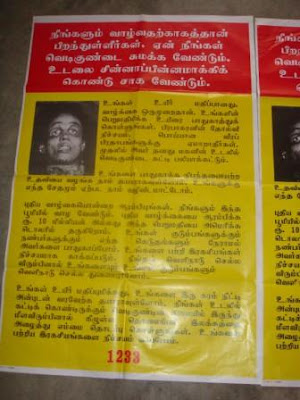 A series of unusual posters have appeared in some of Colombo`s localities. Predominantly seen in Wellawatte and Kotahena, the posters call on the sensibilities of possible suicide bombers.
A series of unusual posters have appeared in some of Colombo`s localities. Predominantly seen in Wellawatte and Kotahena, the posters call on the sensibilities of possible suicide bombers.
Questioning the rationale of dying for a cause that itself is on the brink of collapse, the posters remind its audience that LTTE`s terror leader Prabhakaran is facing an imminent loss. Posing the question why do you want to destroy your life? whilst reiterating that the need to die is not a necessity but the right to live is a requisite for any human being, the posters appeal to the psyche of suicide cadres who are contemplating their life and their death.
A campaign initiated by the Government, it calls upon suicide cadres to see the futility of their lives and questions the sensibility in sacrificing their valuable lives for a cause and a leader who have no future. The posters end with the message we are welcoming you with open arms, get rid of that weight on your chest, call this number and we will assure your safety and confidentiality.
Posted by media at 12:46 AM 0 comments
US State Dept. donates $220,000 worth anti-terrorism equipment to police
 The United States Department of State's Bureau of Diplomatic Security, Office of Antiterrorism Assistance will donate approximately $220,000 worth of equipment to the Sri Lanka National Police (SLNP) in a brief ceremony Tuesday, March 18, 2008 at 9:00 a.m. at the American Embassy.
The United States Department of State's Bureau of Diplomatic Security, Office of Antiterrorism Assistance will donate approximately $220,000 worth of equipment to the Sri Lanka National Police (SLNP) in a brief ceremony Tuesday, March 18, 2008 at 9:00 a.m. at the American Embassy.
The purpose of the equipment is to sustain and enhance the critical capabilities of the security forces of Sri Lanka in their efforts to fight terrorism, according to a media release from the US Embassy in Sri Lanka.
The donation consists of three Explosives Incident Countermeasures kits, two Post-Blast Investigation kits and two Hostage Negotiations kits, which will be divided between the SLNP and the Special Task Force.
IGP Y.P. Victor Perera, as well as Senior Deputy Inspector General – Administration – Mr. Bodhi Liyanage; Senior Deputy Inspector General – Range III – Mr. Mahinda Balasooriya; Senior Deputy Inspector General – Range IV – Mr. Nimal Illangakoon; and Deputy Inspector General – Commandant / Special Task Force – Mr. Nimal Lewke are expected to attend the donation ceremony.
Courtesy: Government Information Department
Posted by media at 12:00 AM 0 comments
Monday, March 17, 2008
India-Sri Lanka power transfer project feasibility report soon
New Delhi, March 15 The feasibility study for the proposed $450-million mega undersea power transmission link between India and Sri Lanka is slated to be ready shortly.
The 200-km submarine cable would enable India to export electricity to the island nation and is likely to be set up with a capacity to wheel around 1,000 MW of electricity, government officials involved in the exercise said.
The report on the HVDC (high voltage direct current) link between the two countries is being prepared by State-owned transmission major Power Grid Corporation of India Ltd (PGCIL), which had earlier estimated that it can set up the link in around 40 months once all clearances are in place, officials said.
The link is likely to connect Madurai in Tamil Nadu and Anuradhapura in Sri Lanka’s North Central Province.
While a joint Steering Committee has been set up to oversee the project, a task force comprising representatives of the Power Ministry, Central Electricity Authority and PGCIL on the Indian side and the Sri Lankan Energy Ministry and Ceylon Electricity Board (CEB) on the other, has been firmed up to study the feasibility report and make recommendations to the Committee.
Officials said Indian utilities could get higher tariffs from electricity supplies to the country. Initially, surplus power would be transmitted from India to Sri Lanka using the link.
With NTPC Ltd, already working on a 500-MW coal fired plant in Trincomalee, wheeling power from Sri Lanka to India could also be a possibility over the long term, they said.
Sri Lanka’s Cabinet of Ministers had, early last year, given its go-ahead to its Energy Ministry on the project and the United States Agency for International Development is reportedly extending technical assistance to Sri Lanka. Sri Lanka currently uses diesel — one of the most expensive power generating resource — for nearly 65 per cent of its power generation. The generation cost there is around Sri Lankan Rupees 15 per unit (about Indian Rs 6.21 per unit), according to CEB data. India currently has transmission links with only Bhutan, as part of the 1,040 MW Tala hydroelectric power evacuation system. The proposal to link-up countries in the South Asian region is being seen as a forerunner to the proposed BIMSTEC power transmission network, which is under active consideration.
Posted by media at 3:47 AM 0 comments
Anura Bandaranaike of Sri Lanka's famous political dynasty dies at 59
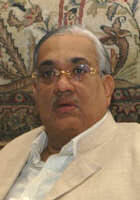 COLOMBO, Sri Lanka: Anura Bandaranaike, a former Sri Lankan foreign minister and member of the country's famous Bandaranaike political dynasty, died Sunday after an illness, a government spokesman said. He was 59.
COLOMBO, Sri Lanka: Anura Bandaranaike, a former Sri Lankan foreign minister and member of the country's famous Bandaranaike political dynasty, died Sunday after an illness, a government spokesman said. He was 59.
Both his parents and his sister led Sri Lanka, but Bandaranaike's own political ambitions were frustrated by political battles within his family.
Bandaranaike was first elected to parliament in 1977 and served as minister of higher education, speaker of parliament and opposition leader, but he was never able to rise to the highest office in this Indian Ocean island nation.
He died Sunday, said government spokesman Anusha Pelpita.
Bandaranaike was appointed foreign minister after his predecessor Lakshman Kadirgamar was assassinated in 2005. He lost the post in a Cabinet reshuffle a few months later, however.
Just a few months before his death, Bandaranaike quit the Cabinet and joined the opposition over differences with President Mahinda Rajapaksa.
Bandaranaike's father, Solomon Dias Bandaranaike, founded the Sri Lanka Freedom Party and served as prime minister from 1956 until his assassination three years later. His mother took office soon after her husband's killing and ruled for a total of 12 years.
His mother chose his sister, Chandrika Kumaratunga, as her political heir instead of him and she ruled the country from 1994 to 2005.
Sunethra, the eldest Bandaranaike sibling, did not take part in politics.
Bandaranaike was born on Feb. 15, 1949.
Posted by media at 12:44 AM 0 comments










